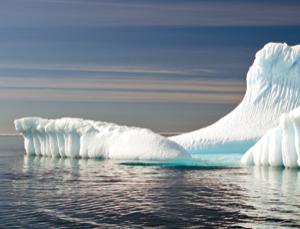Greatest Environmental Change in Human History Will Extend Far Beyond The North Pole
 IT IS smaller, patchier and thinner than ever - and rotten in parts. The extent of the Arctic ice cap has hit a record low, and the consequences of what is arguably the greatest environmental change in human history will extend far beyond the North Pole.
IT IS smaller, patchier and thinner than ever - and rotten in parts. The extent of the Arctic ice cap has hit a record low, and the consequences of what is arguably the greatest environmental change in human history will extend far beyond the North Pole.For at least 3 million years, and most likely 13 million, says Louis Fortier of the University of Laval in Quebec City, Canada, the Arctic Ocean has been covered by a thick, floating ice cap, the breadth of which fluctuates with the seasons and currents. Each summer, the cap shrinks to an annual minimum in mid-September before growing out again, fuelled by plummeting winter temperatures and long nights.
Climate change has had more of an impact here than anywhere else on Earth. Air temperatures are rising twice as fast as the global average, and models predict that the region could see temperatures rise by between 6 °C and 14 °C by 2100, depending on how fast the sea ice disappears. Nobody believes the world’s northern ice cap could survive such scorching summers.
Constant, real-time monitoring made it evident last week that this would be a landmark year, even worse than 2007, when the summer thaw opened the North-West Passage for the first time in living memory. On 27 August, the daily update from the US National Snow and Ice Data Center (NSIDC) reported that the ice pack had shrunk to 4.1 million square kilometres (see diagram). That is 70,000 km2 smaller than the 2007 low, and there are several weeks to go before the ice starts growing back as winter approaches. (To see an interactive diagram showing the summer ice extent for every year from 1979 to 2011, see our interactive map.)
Less ice in the Arctic means more light enters the ocean beneath, fuelling more life (see “What ice-free summers will mean for Arctic life”), but it also means warmer surface waters and more energy released into the atmosphere. That energy drives cyclones, which generate mammoth waves capable of ripping into the ice pack, degrading it further. The consequences are not good for this highly specialised environment, and the knock-on effects for the rest of us could be severe.
Even the NSIDC’s figures for ice coverage, from satellite data, could be overestimations, as satellite images cannot distinguish between pack ice and slushy, “rotten” ice.
Measurements of ice thickness are also worrying. From 1979 to 2000, the average volume of Arctic ice in September was 12,000 cubic kilometres. This year, it is less than 3000 cubic kilometres. “In plain words,” says Fortier, “we are three-quarters of the way to a summertime ice-free Arctic Ocean, with all the climatic, geopolitical, environmental and economic consequences.”
Several factors are to blame. Warm spring temperatures didn’t help, then on 5 August a major cyclone crossed into the Arctic Circle. Such events used to be rare, but are now more frequent, stronger and last longer than before, says Ziangdong Zhang at the University of Alaska Fairbanks (Journal of Climate, doi.org/d2d6n6).
These storms carry heat from the lower latitudes, and stir up the highly stratified Arctic Ocean waters, bringing warm bottom-waters up to the surface, where they help further melting of the floating ice. More dramatic is the storms’ direct physical influence. With the Arctic water no longer protected by thick multiyear ice, near-hurricane-force winds shove it around, forming powerful waves capable of shredding any ice floes they encounter.
Dave Barber and Matthew Asplin at the University of Manitoba in Winnipeg, Canada, witnessed this in September 2009 aboard an ice-breaker called Amundsen. They were near an ice floe 10 kilometres across and up to 10 metres thick in places. “We were about to put a team down on the ice when all of a sudden I saw a wave enter the ice pack,” Barber recalls. “The entire floe rose up on top of the wave trains, and as it came down on the other side, it split. As I watched, it broke into small pieces 100 metres across.”
Smaller pieces melt faster, so the researchers believe cyclones are an important positive feedback mechanism, further reducing the pack ice (Journal of Geophysical Research - Oceans, doi.org/h7m).
Zhang points out that cyclones also carry clouds, which boost downward radiation. He says the August cyclone probably contributed to this year’s low. Bill Chapman at the University of Illinois at Urbana-Champaign agrees. “Sea-ice area decreased rapidly during the period of the storm,” he says, “but it was decreasing rapidly already during the height of this melt season.”
The upheaval will not be confined to the Arctic Circle. The atmospheric-temperature gradient between the hot tropics and the cold poles powers much of our planet’s weather and water cycles. It drives the jet stream, for instance, which pushes global weather systems, it fuels the winds that power ocean currents, and it distributes moisture around the planet.
You can return to the main Market News page, or press the Back button on your browser.

